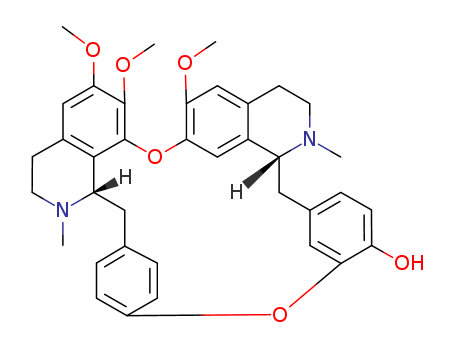Chemical Property of Oxyacanthine
Edit
Chemical Property:
- Vapor Pressure:1.19E-20mmHg at 25°C
- Melting Point:216-217°
- Refractive Index:1.601
- Boiling Point:707°Cat760mmHg
- PKA:9.42±0.20(Predicted)
- Flash Point:381.4°C
- PSA:72.86000
- Density:1.204g/cm3
- LogP:6.73520
- XLogP3:6.3
- Hydrogen Bond Donor Count:1
- Hydrogen Bond Acceptor Count:8
- Rotatable Bond Count:3
- Exact Mass:608.28863700
- Heavy Atom Count:45
- Complexity:963
- Purity/Quality:
-
99% *data from raw suppliers
OXYACANTHINE 95.00% *data from reagent suppliers
Safty Information:
- Pictogram(s):
- Hazard Codes:
- MSDS Files:
-
SDS file from LookChem
Useful:
- Canonical SMILES:CN1CCC2=CC(=C(C3=C2C1CC4=CC=C(C=C4)OC5=C(C=CC(=C5)CC6C7=CC(=C(C=C7CCN6C)OC)O3)O)OC)OC
- Isomeric SMILES:CN1CCC2=CC(=C(C3=C2[C@@H]1CC4=CC=C(C=C4)OC5=C(C=CC(=C5)C[C@@H]6C7=CC(=C(C=C7CCN6C)OC)O3)O)OC)OC
-
Description
This alkaloid was first obtained by Hesse from Berberis vulgaris and is also a
minor constituent of other Berberis and Mahonia species. When recrystallized
from EtOH it forms clusters of colourless needles, m.p. 208-214°C, the higher
melting point given above being obtained in vacuo. It has [α]D + 131.6°
(CHC13), a much higher value of + 279° (CHCI3) being given by Gericke and
Bruchhausen. The dihydrochloride forms needles, m.p. 270-1°C (vac.); [α] +29
D+ 188.5° (H20) and is only sparingly soluble in dilute HC1; the hydrobromide has
m.p. 273-5°C (dec., vac.) and the nitrate forms colourless needles, m.p. 195-
200°C (dec.). The presence of the phenolic hydroxyl group is indicated by the
formation of an O-benzoy1 derivative, a potassium salt and the O-methyl ether,
giving a hydrochloride, m.p. 261°C. The structure has been deduced from chem_x0002_ical and spectroscopic data. Various colour reactions have been described, e.g.
the alkaloid is not coloured by H2S04, gives a yellow colour with HN03 and
with molybdic acid in H2S04 produces a violet colour, slowly changing to
yellow-green.






